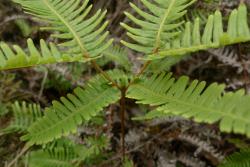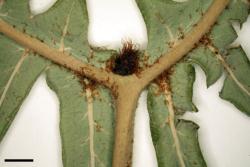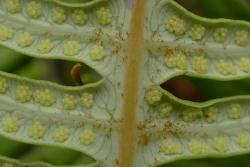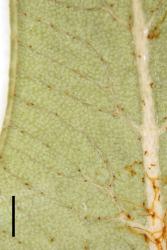- = Mertensia Willd., Kongl. Vetensk. Acad. Nya Handl. 25: 165 (1804) nom. illeg., non Mertensia Roth 1797
Terrestrial ferns. Rhizomes long-creeping, hairy. Stipes hairy or glabrescent. Rachis reduced to a bud at the apex of the stipe with a single pair of pinnae; rachis buds sometimes extending to produce another tier comprising a rachis terminating in another rachis bud and pair of pinnae. Pinnae unforked, being equivalent to a single ultimate leaflet (rarely NZ), or forking pseudodichotomously 1–2 times; buds at bifurcations sometimes extending once. Laminae, axes, and rachis and pinna buds hairy, these hairs sometimes branched, scales absent. β costae lacking costal segments. α costae of the ultimate leaflets arising pseudodichotomously from distal end of β costae. Ultimate segments on α costa >10 mm long, oblong, entire, with veins branching two or more times between midvein and margin. Sori superficial, 6–20 either side of midvein, each with 7–12 sporangia. Spores trilete, radially symmetrical, plain or shallowly rugulate.
A genus of 10–20 species. Species limits are poorly defined, with the widespread Dicranopteris linearis particularly problematic.
Allan (1961) included Dicranopteris in a broadly-circumscribed Gleichenia. The nomenclatural history of Dicranopteris was detailed by Pichi Sermolli (1972). Dicranopteris Bernh. is a replacement name for Mertensia Willd., a later homonym of Mertensia Roth (Boraginaceae). Bernhardi (1805) lectotypified Mertensia Willd. (and Dicranopteris by extension) by including in his new genus only one of the species from Willdenow’s genus, M. dichotoma (Thunb.) Willd. (≡ Polypodium dichotomum Thunb. ≡ D. dichotoma (Thunb.) Bernh.).
Dicranopteris can be distinguished from the superficially-similar Sticherus by the absence of lamina on the axes subtending the pseudodichotomously-paired ultimate leaflets; that is, Dicranopteris has no costal segments on the β costae, whereas Sticherus does. The ultimate segments of Dicranopteris are at least 11 mm in length, in contrast to Gleichenia, which has ultimate segments less than 3 mm long. In New Zealand, Dicranopteris is only found in geothermal areas of the central North Island.
Ten to twenty species distributed throughout the tropics and subtropics, extending to southern temperate Australia and New Zealand; about three to five species in each of America (Mickel & Smith 2004), Africa and neighbouring islands (Roux 2009), India (Fraser-Jenkins 2009), China and Japan (Xiaofeng et al. 2013), Malesia (Holttum 1959), and the Pacific (Minagawa & Kuratsuji 2008), with one in Australia (Chinnock & Bell 1998). One non-endemic species in New Zealand.
| Category | Number |
|---|---|
| Indigenous (Non-endemic) | 1 |
| Total | 1 |
The base chromosome number in Dicranopteris is x = 39 (Kramer 1990).
Holttum (1957, p.170) pointed out that the hairs of Dicranopteris are often branched, particularly at the base, which may be "rather massive, not hair like". Nevertheless, the ‘hairs’ of Dicranopteris are markedly different from the scales and other indumentum found in Gleichenia and Sticherus, and this terminological convention is widely followed.







